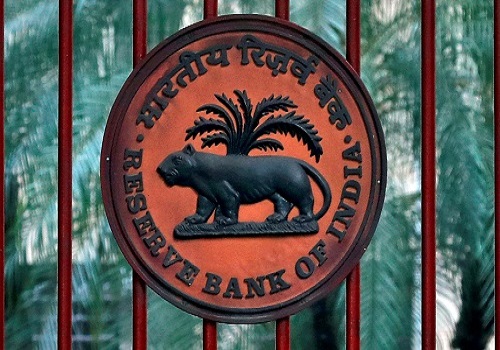India Strategy : Time value of money to gain importance as NIFTY50 transitions from an era of ‘earnings mirage’ to ‘earnings growth’ - ICICI Securities

Follow us Now on Telegram ! Get daily 10 - 12 important updates on Business, Finance and Investment. Join our Telegram Channel
https://t.me/InvestmentGuruIndiacom
Download Telegram App before Joining the Channel
Time value of money to gain importance as NIFTY50 transitions from an era of ‘earnings mirage’ to ‘earnings growth’
* Earnings mirage from 2014-19 did not add to ‘time value’ of money as growth stagnated: NIFTY50 trailing EPS for Dec’19 (pre-covid) stood at ~475 compared to the earnings five years prior of ~435 during Dec’14. However, in Dec’14, street expected NIFTY50 index to compound earnings at a CAGR of ~21% over the next two years to ~611. As time rolled forward, the trailing and the forward earnings stagnated as earnings kept disappointing due to volatile earnings of cyclicals and a few defensives such as telecom and pharma, thereby, resulting in downgrades.
* Stocks with volatile earnings contributing ~61% to NIFTY50 earnings are finally showing traction, which is expected to continue. This brings forth the importance of ‘time value of money’ as each incremental quarter will accumulate ~5-6% to earnings base. Earnings disappointment over CY14-19 emanate from cyclicals as well as some defensives such as telecom and pharma, which collectively have 61% weightage in NIFTY50’s free-float earnings. In other words, just 39% of index earnings continued to grow in a sustained way without contraction driven by FMCG, IT, RIL and utilities. However, volatile earnings segment of the market has started showing earnings growth traction and the NIFTY50 EPS is expected to grow at a CAGR of ~20% going ahead driven largely by cyclicals; the recent trend of earnings beats and upgrades indicates that expectations are not unrealistic.
* Second wave to have limited impact on economic recovery going by trends in DMs, availability of vaccines and lower fatality rate – Second wave of covid hit the US economy from Nov’20 onwards with daily new cases and daily deaths rising much more than those seen during the first wave with non-availability of vaccines. However, economic indicators remained resilient with the US GDP for Oct-Dec ’20 increasing to 4.1% and high frequency manufacturing and services indicators like PMI and ISM indicating MoM expansion. Trend is corroborated by the latest print of Global Manufacturing PMI for Mar’21, which hit 10-year high at 55. Similar outcome of the second wave can be expected from India with largest impact seen on leisure sector in few states while essential services, digital services, manufacturing, mining, agriculture and construction will remain largely unaffected. Availability of vaccine and lower case fatality rate are added advantages as compared to first wave. High frequency data for Indian economy during March’21 remained robust – GST collection of Rs1.23trn; manufacturing PMI continuing to expand MoM at 55.4; robust exports (US$34bn) and imports (US$58bn) despite base effects. However, core sector growth for Feb’21 disappoints at -4.6%.
* Why will earnings grow and not disappoint from hereon?
* Revival in aggregate demand and investments, lower interest rates and stronger corporate balance sheets: Governments, globally, are driving counter cyclical fiscal policies which are being augmented by QE from major central banks, thereby, increasing the likelihood of a global revival in demand (IMF expects India to lead global growth at 11.5% in CY21). India, in particular, has concentrated its fiscal fire power towards boosting infrastructure and manufacturing; a similar plan worth multi-trillion dollars is in the works by the Biden administration for the US. Lower interest rates and improving financial strength of corporate India are additional catalysts for the investment cycle.
* Mean reversion of PAT/GDP ratio: We believe the PAT/GDP ratio in listed space has bottomed out at a two-decade low of ~2% as loss pools and depressed earnings continued to recede in FY21E within domestic cyclicals as well as some of the defensive sectors such as telecom and pharma despite the recession caused by covid.
* Reasonable expectations: Consensus sales CAGR expectations of 8% over FY20-23 for top 360 stocks does not build high optimism around pick-up in aggregate demand.
* Signs of sustained ‘value rotation’ and firm commodity prices after a decade of growth/low volatility outperformance is reflecting the collective wisdom of the market towards the expected earnings traction from cyclicals.
* Valuations remain polarised despite rally in cyclicals: Valuations remain expensive for low volatility/growth stocks but reasonable for cyclicals (Refer our note on P/B Z score dated 19 Mar’21) as ~50% of the NSE200 universe has a negative P/B Z score
To Read Complete Report & Disclaimer Click Here
For More ICICI Securities Disclaimer https://www.icicisecurities.com/AboutUs.aspx?About=7
Above views are of the author and not of the website kindly read disclaimer























